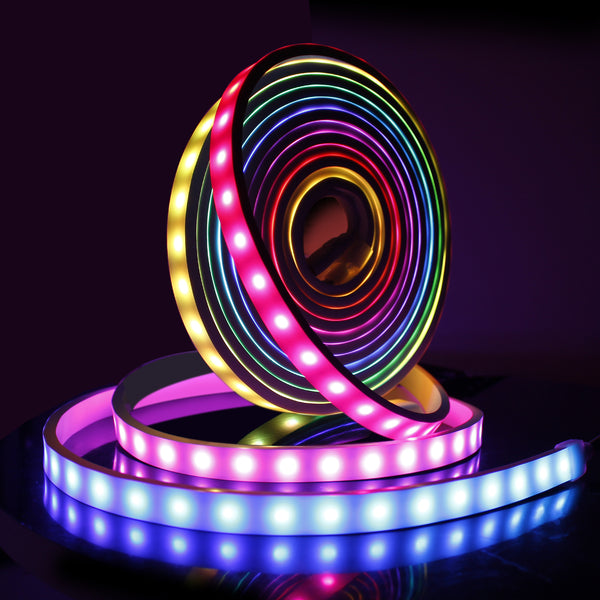Lighting over stairs is not only essential for safety purposes but can also enhance the aesthetics of your space. In this complete guide, we will explore the different options for lighting stairs and provide tips on how to properly place and size your lighting fixtures.

How to Illuminate Foyer Stairs
Foyer stairs or stairs near the hallway are often the focal point of your entryway. To enhance the lighting and visual appeal, consider hanging a chandelier or pendant lights. The placement of these fixtures depends on the available space. If there is enough room around the stairwell, the chandelier can be installed either over the stair landing or in the empty area around the stairwell. However, make sure there is a minimum of 35-40 inches of horizontal empty space to prevent accidental touches and swinging of the chandelier.
Read more: How to Maintain Your LED Lights: A Comprehensive Guide
Sizing a Chandelier for the Stairwell
To determine the appropriate length of a chandelier for a stairwell with a high ceiling (14 feet and above), simply divide the length of the ceiling from the floor (in inches) by 4. This will give you the recommended chandelier length in inches. For stairwells with average ceiling height (9-13 feet), divide the ceiling height (in inches) by 2 to find the ideal chandelier length. Keep in mind that these values are based on design standards, but custom chandeliers can also be used to tailor the lighting perfectly to your space.
Pendant Lights for Foyer Stairs
Pendant lights are another great option for illuminating foyer stairs. They can be installed around the stairwell or over the stair landing, depending on the available space. When installing pendant lights around the stairwell, aim for a length of 38-48 inches, with a width of 13-15 inches for a single pendant light. If using multiple pendant lights, ensure that the total width does not exceed 40 inches.
Read more: How to Easily Install LED Strip Lights Around Corners
How to Light Basement Stairs
When illuminating basement stairs, it's important to consider the brightness and potential glares. Hanging light fixtures like chandeliers and pendant lights are not recommended as they can cause glares. Instead, opt for a flush mount light fixture on the ceiling above the stairs. This type of fixture provides even lighting and doesn't take up much space. You can also add wall sconces to counter shadows if needed.
Proper Placement for Basement Stair Lighting
For basement stairs without a landing, the light source should be placed directly above the first stair. This prevents glares and ensures even lighting throughout the staircase. If you have a basement stair landing, you should install light sources both above the first stair and above the landing. This provides adequate illumination for the entire stairwell. Avoid using chandeliers in narrow stairwells and opt for flush mount lights instead.
How Bright Should Basement Stair Lighting Be?
To determine the brightness of the light fixture for basement stairs, measure the height of the ceiling in feet from the first stair. Square this value and multiply it by 12 to get the recommended minimum lumen requirement. For example, if the ceiling height is 9 feet, the light source should have a minimum brightness of 972 lumens. This ensures proper illumination without any dark spots.
Read more: BLLS-Lighting is a website that provides information about led lights and lighting devices
Additional Lighting Options for Stairs
LED strip lights and recessed stair lights are great options for adding accent lighting to your stairs. LED strip lights can be easily installed along the edges of your steps, providing a subtle glow. Recessed stair lights are ideal for outdoor stairs and can be installed within the wall near each step. These lights illuminate each step individually and are perfect for added safety.
Remember to choose a color temperature between 4000K-6000K for your stair lighting, as this provides a bright and focused light for optimal visibility. LED bulbs are the most energy-efficient and long-lasting option, making them a popular choice for stair lighting.
Now that you have a complete guide to properly lighting and sizing your stairs, you can transform this often overlooked space into a well-lit and visually appealing area in your home.
Frequently Asked Questions
Q: How many wall sconces should I use for basement stairs?
A: Adding two wall sconces at dark spots around the stairwell can help improve the illumination of basement stairs. LED wall sconces can provide around 500-600 lumens of brightness and should be placed at a height of 2-2.5 feet from the stairs.
Q: Can track lights be used in basement stairs?
A: It's not recommended to use track lights in basement stairs as they can cause glares and uneven distribution of light. A single flush mount light fixture is preferred for most basement stairs.
Q: What color temperature is best for stairway lighting?
A: Daylight color temperature (4000K-6000K) is ideal for stairway lighting. This color temperature provides a focused and bright light, allowing for accurate perception of individual stairs.
Q: Which type of light bulb is recommended for stairway lighting?
A: LED bulbs are the most recommended for stairway lighting. They are bright, energy-efficient, and have a long lifespan of up to 50,000 hours. LED bulbs provide optimal illumination for stairs.
Q: How bright are LED strip lights?
A: LED strip lights provide around 400-450 lumens of illumination per foot. They are commonly used to add an accent to each step and can be easily installed along the edges of stairs. The flexible LED strip lights are the most widely used for stairs.







